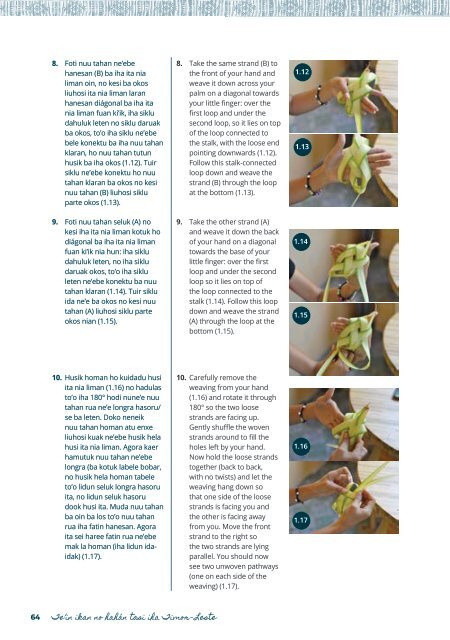You also want an ePaper? Increase the reach of your titles
YUMPU automatically turns print PDFs into web optimized ePapers that Google loves.
8. Foti nuu tahan ne’ebe<br />
hanesan (B) ba iha ita nia<br />
liman oin, no kesi ba okos<br />
liuhosi ita nia liman laran<br />
hanesan diágonal ba iha ita<br />
nia liman fuan ki’ik, iha siklu<br />
dahuluk leten no siklu daruak<br />
ba okos, to’o iha siklu ne’ebe<br />
bele konektu ba iha nuu tahan<br />
klaran, ho nuu tahan tutun<br />
husik ba iha okos (1.12). Tuir<br />
siklu ne’ebe konektu ho nuu<br />
tahan klaran ba okos no kesi<br />
nuu tahan (B) liuhosi siklu<br />
parte okos (1.13).<br />
9. Foti nuu tahan seluk (A) no<br />
kesi iha ita nia liman kotuk ho<br />
diágonal ba iha ita nia liman<br />
fuan ki’ik nia hun: iha siklu<br />
dahuluk leten, no iha siklu<br />
daruak okos, to’o iha siklu<br />
leten ne’ebe konektu ba nuu<br />
tahan klaran (1.14). Tuir siklu<br />
ida ne’e ba okos no kesi nuu<br />
tahan (A) liuhosi siklu parte<br />
okos nian (1.15).<br />
8. Take the same strand (B) to<br />
the front of your hand and<br />
weave it down across your<br />
palm on a diagonal towards<br />
your little finger: over the<br />
first loop and under the<br />
second loop, so it lies on top<br />
of the loop connected to<br />
the stalk, with the loose end<br />
pointing downwards (1.12).<br />
Follow this stalk-connected<br />
loop down and weave the<br />
strand (B) through the loop<br />
at the bottom (1.13).<br />
9. Take the other strand (A)<br />
and weave it down the back<br />
of your hand on a diagonal<br />
towards the base of your<br />
little finger: over the first<br />
loop and under the second<br />
loop so it lies on top of<br />
the loop connected to the<br />
stalk (1.14). Follow this loop<br />
down and weave the strand<br />
(A) through the loop at the<br />
bottom (1.15).<br />
1.12<br />
1.13<br />
1.14<br />
1.15<br />
10. Husik homan ho kuidadu husi<br />
ita nia liman (1.16) no hadulas<br />
to’o iha 180° hodi nune’e nuu<br />
tahan rua ne’e longra hasoru/<br />
se ba leten. Doko neneik<br />
nuu tahan homan atu enxe<br />
liuhosi kuak ne’ebe husik hela<br />
husi ita nia liman. Agora kaer<br />
hamutuk nuu tahan ne’ebe<br />
longra (ba kotuk labele bobar,<br />
no husik hela homan tabele<br />
to’o lidun seluk longra hasoru<br />
ita, no lidun seluk hasoru<br />
dook husi ita. Muda nuu tahan<br />
ba oin ba los to’o nuu tahan<br />
rua iha fatin hanesan. Agora<br />
ita sei haree fatin rua ne’ebe<br />
mak la homan (iha lidun idaidak)<br />
(1.17).<br />
10. Carefully remove the<br />
weaving from your hand<br />
(1.16) and rotate it through<br />
180° so the two loose<br />
strands are facing up.<br />
Gently shuffle the woven<br />
strands around to fill the<br />
holes left by your hand.<br />
Now hold the loose strands<br />
together (back to back,<br />
with no twists) and let the<br />
weaving hang down so<br />
that one side of the loose<br />
strands is facing you and<br />
the other is facing away<br />
from you. Move the front<br />
strand to the right so<br />
the two strands are lying<br />
parallel. You should now<br />
see two unwoven pathways<br />
(one on each side of the<br />
weaving) (1.17).<br />
1.16<br />
1.17<br />
64<br />
Te’in ikan no hahán tasi iha Timor - <strong>Leste</strong>

















